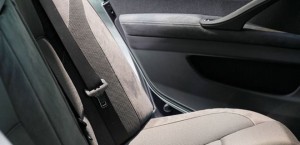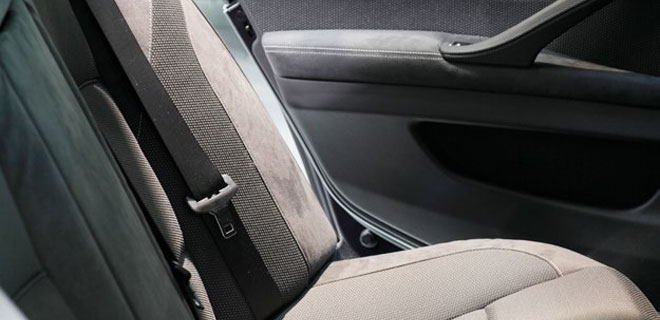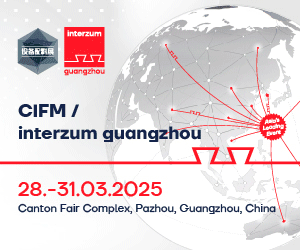 Even today, the average car has around 30 kilograms of textiles, according to the German Textil research board of trustees. And this is a growing trend, as high-performance and intelligent fibers, yarns and compound materials are assuming an ever greater number of comfort, safety, acoustic and fuel-saving functions in the age of light-weight construction.
Even today, the average car has around 30 kilograms of textiles, according to the German Textil research board of trustees. And this is a growing trend, as high-performance and intelligent fibers, yarns and compound materials are assuming an ever greater number of comfort, safety, acoustic and fuel-saving functions in the age of light-weight construction.
The Oerlikon Manmade Fibers Segment of the Swiss Oerlikon Group drove this attractive future market – with high-end solutions for manufacturing quality industrial yarns. At this year’s Techtextil, took place in Frankfurt between May 4 and 7, the solution provider with its two brands – Oerlikon Barmag and Oerlikon Neumag – offered numerous technologies for manufacturing industrial yarns, fibers and nonwovens. The latest developments were presented at the 90 m² booth in hall 3, B06, in a Virtual Showroom in 3D.
The global market for industrial textiles is expanding considerably and automotive construction is the number one consumer. A Commerzbank study carried out in 2014 outlines some very interesting figures here: according to the information, the global market for industrial textiles (without nonwovens and composites) totaled US$ 133 billion in 2012 with a production volume of 22 million tons and is set to rise to US$ 160 billion by 2018. In 2010, with a slightly lower market volume than in 2012, automotive construction made up the lion’s share of sales with 23 percent – considerably ahead of the second-placed, industrial solutions (17 percent).
It seems unlikely that these rankings have meanwhile changed significantly. Because the main drivers in the automobile industry are weight reduction and rising vehicle production – and it is here that the textile sector is developing ever more innovations. In Germany alone, around 50 medium-sized textile companies with 10,000 members of staff working as automobile sector suppliers are generating a turnover of more than € 4 billion, as outlined in a brochure published by the Textil research board of trustees in 2012. Today, car roofs, body parts and interior components such as claddings, switches and operating elements are being manufactured from industrial textiles. And the development laboratories are working on further, quite literally smart materials for the cars of the future.
High-Tech For Seat Belts
However, the research does not focus solely on new product ideas. Due to tremendous price and competition pressures within the automobile industry, there is a renewed concentration above all on the efficient production of such textiles or their economic contribution to automobile construction. Here, Oerlikon Barmag – the leader in the manufacture of spinning and texturing systems for manmade fibers – is able to bring diverse strengths to the table.
These start with the production of yarns for safety belts. And this requires high-tech: the fabric construction should not solely restrain people inside vehicles during impact as they would be injured by the belts. Moreover, these fabrics should give, hence reducing or delaying the force exerted on the body. In the case of this principle, the individual fibers rubs against each other and therefore give in a defined manner. Belts that have been subjected to expansion must not be reused as they have by then lost their protective effect. “The manufacture of the belt yarn therefore has to comply with such challenging requirements as absence of lint, dyeability and perfect package build”, explains Ulrich Enders, Head of Development at Oerlikon Barmag in Remscheid.
These are made possible by machine concepts with up to 8 ends for the efficient production of high-tenacity, lint-free PET yarn with titers of up to 1,500 denier for safety belts. To this end, the special SFL (Single Filament Layer) technology guarantees an extremely gentle yarn path with even heating and drawing of the individual filaments using five pairs of heated godets. And the new WinFors winder also ensures an equally very even package build for these filaments. Its cam shaft traverse system is particularly suited for high filament titers. And a high degree of transfer reliability and constant filament properties along the entire package are also achieved by means of the tried-and-tested co-current yarn catching system. “Tests in collaboration with a major belt manufacturer are able to confirm that our machine technology fulfills the high demands and requirements of this application. Within this partnership, we are also currently researching optimized solutions for tangling the individual filaments for improved further processing”, comments Stefan Becker, senior expert for industrial yarn application technology at Oerlikon Barmag.
More Polyester For Airbags
And the described machine technology is also perfect for finer airbag yarns made from polyamide or polyester. Here, the resistant polyester fiber is increasingly becoming an interesting alternative to polyamide, which has meanwhile become almost three times as expensive. “Currently, our customers continue to manufacture most airbag yarns from nylon. As a result of the ever growing diversity of airbag applications and also the ever larger systems – such as side, curtain and meanwhile also pedestrian airbags – the less expensive polyester is being increasingly focused on”, states Stefan Becker.
Against this background, cost-efficient manufacture is quite a challenge for producers. But this is where Oerlikon Barmag technologies can make an invaluable contribution: up to 12, in specific cases also up to 16, polyester filaments can be manufactured on the machine using special spin packs. Here, the technology excels not just in terms of its high productivity and low energy consumption, but also with regards to its precision. To this end, threads used for airbags has particularly fine filaments as a result of the special fabric construction and are therefore more sensitive to friction. The design of the system caters to this with a special yarn guide. All in all, the spinning machines fulfill all high quality standards for airbags, which – unlike virtually all other textile products in vehicle construction – have to ensure the greatest degree of safety for occupants. And all this without any loss of function in any climate anywhere in the world for the lifetime of the vehicle.
Tire Cord Yarns Help Save
As one of just two manufacturers worldwide, Oerlikon Barmag also produces machines for HMLS (high-modulus low-shrinkage) yarns. These preliminary polyester products are primarily deployed for manufacturing tire cord. They are extremely tear-resistant, while nevertheless remaining highly elastic and stable in terms of their dimensions and temperature. This is important to ensure the tire also retains its shape when it is insufficiently inflated and heats up more due to the corresponding increased friction on road surfaces. The cord, a fabric made from twisted HMLS filaments, is united with the tire rubber at approximately 200 degrees Celsius. It lies between several layers of rubber and stabilizes the entire car tire on roads.
The EvoQuench HMLS system was developed for manufacturing such challenging HMLS yarns. It deploys so-called radial quenching for the filaments to ensure their extremely even cooling following spinning. This technology enables the manufacture of products with very high numbers of filaments and improves the quality of the individual threads. At the same time, a special air flow concept generates huge savings: the air consumption decreases by around 65 percent, while the energy consumption for the cooling system is reduced by at least half compared to conventional cross-flow quenching systems.
And the Oerlikon Barmag system also offers components with a high degree of effectiveness in other places, hence consuming all in all up to 20 percent less energy than comparable machines. Overall, this allows manufacturing costs to be considerably reduced. “We are also in the process of developing a new technology for the next generation of HMLS yarns with higher dimensional stability and tenacities in excess of 7.5 cN/dtex. This means even less yarn consumption and lighter tires, hence reducing both rolling resistance and fuel consumption”, states Andreas May. And HMLS or HT (high-tenacity) yarns with higher tenacities and medium shrinkage are also used for fan belts and hoses. Furthermore, the HT concept is also deployed for the manufacture of yarns with low shrinkage values (up to 4 percent) for vehicle tarpaulins, with values of as little as 1.5 percent achievable with the X-SLS (super-low shrinkage) concept. Here, both concepts permit 6- to 8-end or 12- to 16-end systems.
Spun-Dyed POY For Seat Upholstery And More
Furthermore, Oerlikon Barmag also supplies automobile POY yarn solutions. To this end, the proven dynamic mixing principle of the 3DD mixer enables textile yarns to be dyed during the manufacturing process. This spun-dyed POY is further processed into air-textured yarn and used in seat upholstery, roof linings and door claddings. Here, the three-dimensional, highly-efficient mixing principle permits outstanding dispersive and distributive mixing of, for example, dye concentrates, fillers and additives that are fed into the polymer melt. Even small amounts and additives with vastly differing viscosities with a ratio of 1:100 can be homogeneously mixed and distributed. The mixer set-up can be adapted to various applications, while important performance parameters, such as mixer speed, can be set to the desired process in a targeted manner. Hence, the patented system offers increased flexibility when manufacturing products of the very highest quality.
Smart Textiles Act İntelligently İn Vehicles
The textile future of the car has for many years not been restricted merely to carbon fiber-reinforced plastics (CRPs) for light-weight construction. Textile research laboratories are already working on smart textiles for vehicle interiors: invisible electrically-conductive fabrics for textile heating and cooling systems in seats; sensitive textile panels that can convert hand movements into gear shifting signals; illuminating LED yarns for pinpointed orientation; textile sensor systems for bio-monitoring drivers with the aim of identifying threatening conditions such as fatigue and stress. For sound insulation, researchers are working on replacing foam materials with new, recyclable compound materials comprising nonwovens, flocked textiles and membranes. Some ideas draw on nature: here, special fiber compound components can supposedly practically themselves ‘repair’ a tear in the component following impact – much in the same way as broken bones are able to heal themselves in the body..










